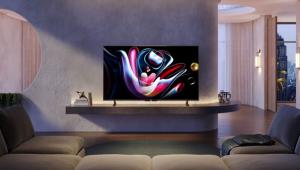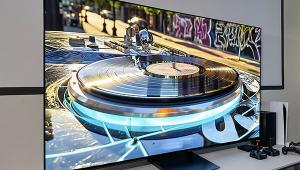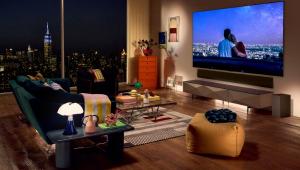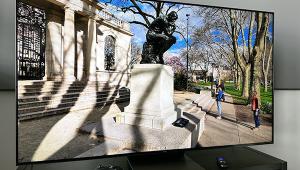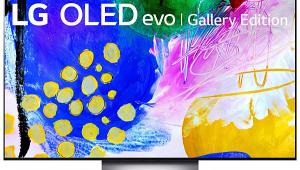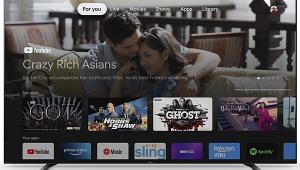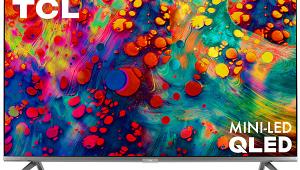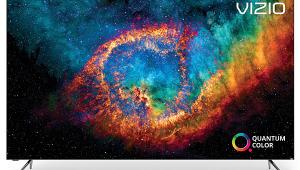Your review did not mention any offering of HDR10 Plus on this set, but I presume it has it because last year's model did. This is an advantage over the LG, which stubbornly does not offer it, and is one reason I would recommend this set over the LG. I presume also that the panel itself on this set is still made by LG, which was also not mentioned. The only difference is in the electronics applied to the panel.
Sony XBR-65A8H OLED Ultra HDTV Review
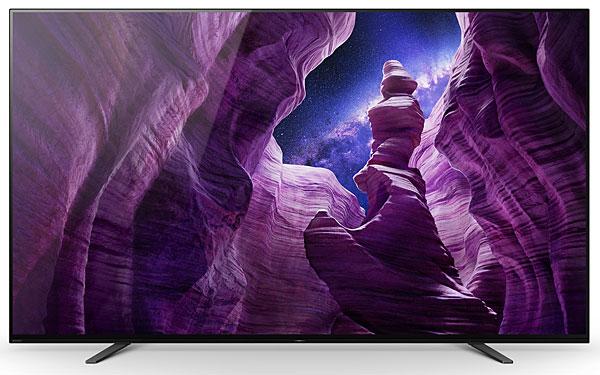
AT A GLANCE
Plus
Unsurpassed contrast
Superior color and resolution
Wide viewing angle
Minus
Complicated menu system
No HDMI 2.1
THE VERDICT
Sony's latest OLED measures up to the best, including the company's 2019 Top Pick of the Year-winning Master Series model, and comes in at notably lower price.
We previously reviewed Sony's XBR-65A9G OLED, a member of the company's Master Series Ultra HDTV family. While that set is still available and remains a first-class option, the only advantages it appears to offer over the new XBR-65A8H OLED reviewed here are slightly more sophisticated sound features plus an ability to serve as a center channel in an outboard multichannel audio setup. The XBR-65A8H, meanwhile, is priced considerably lower than its Master Series predecessor at $2,800.
Features and Setup
The XBR-65A8H rests on legs positioned 40 inches apart for a tabletop setup, allowing it to sit securely on any solid piece of furniture you might reasonably choose for a 65-inch diagonal (57-inch wide) television.
Sony uses Google's Android TV as its smart TV platform. Chromecast built-in lets the set play files streamed over your home network, mirror programs displayed on a portable device or computer screen and respond to limited vocal commands using Google Assistant. The XBR-65A8H is also compatible with Amazon's Alexa voice assistant.
Sony's Acoustic Surface technology in the XBR-65A8H uses left and right audio actuators attached to the back of the OLED panel that vibrate the screen itself to produce sound. There's also a separate woofer radiating from the back of the set. I heard no deep bass to speak of, but the overall sound was as well balanced and listenable, and better than what you get with most flat-panel TVs. Sony claims that the XBR-65A8H supports Dolby Atmos, though none of the speakers contained within the set itself fire upward to create steered sound from overhead—the whole point of Atmos.
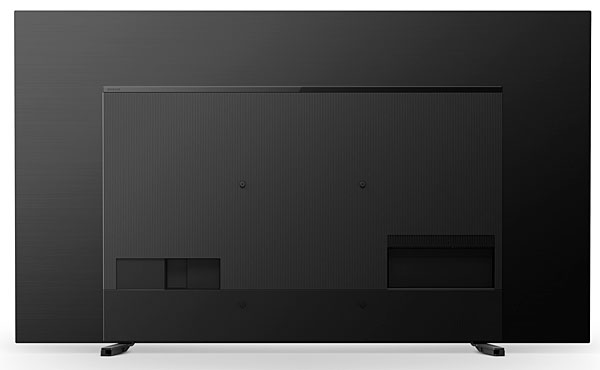
The XBR-65A8H supports the HDR10, HLG, and Dolby Vision high dynamic range formats. Its HDMI inputs are version 2.0, with eARC (Enhanced Audio Return Channel) being the only supported HDMI 2.1 feature. No future upgrade path to full HDMI 2.1 is planned, though all four of the set's HDMI inputs do support the full 18 Gbps bandwidth required to pass today's Ultra HD 4K HDR sources in 10-bit color. (Eight-bit color is standard for all SD and HD video sources.)
If an HDR source has been mastered with a higher peak white level than a given HDR display can handle (which is commonly the case), the signal must be "tone mapped" to prevent visible white clipping. Metadata encoded into all HDR sources tells a display how to do this. This source metadata is "static" for HDR10 material; that is, it provides a fixed correction from the beginning of a source to the end. But many modern Ultra HD sets use internal processing to analyze the program material and create their own dynamic metadata on the fly, generating corrections frame by frame. The Sony performs this through its most advanced processor, the X1 Ultimate, which also serves to upscale lower-resolution sources to 4K.
The 65A8H offers seven picture modes for either SDR or HDR10. Of these, I chose Custom. While there's a Game mode, the set offers no specialized gaming features such as VRR (Variable Refresh Rate) and ALLM (Auto Low Latency Mode).
There are three dedicated Dolby Vision Picture Modes: Dolby Vision Dark, Dolby Vision Bright, and Vivid. I preferred to use Dolby Vision Bright. There's also a Netflix Calibrated Mode, though you'll need to access that from the Picture Settings menu inside Sony's TV control app. Both 2-point and 10-point white balance calibration controls are provided in the Adv. color temperature menu, plus a full color management system (labeled Per color adjustment).
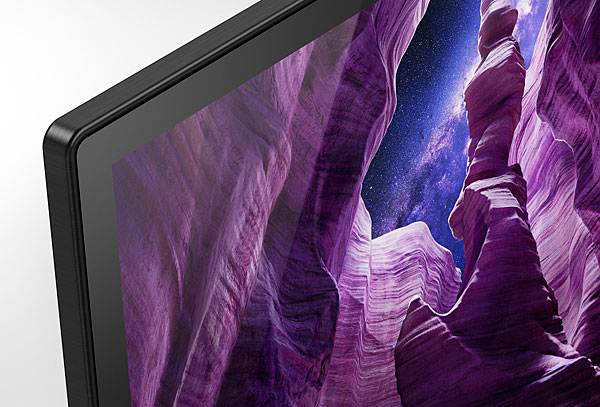
Sony's Motionflow motion smoothing feature offers both Auto and Custom active modes. Custom allows the user to manually adjust the balance between frame interpolation (the Smoothness control) and black frame insertion (the Clearness adjustment). While Motionflow works somewhat better than competing motion blur solutions, I chose to leave it off. Neither Auto nor the other settings I tried offered smoother motion without adding a film-as-video look (the infamous "soap-opera effect"), darkening the image, or both.
The Reality Creation feature found in the set's Clarity menu is Sony's sophisticated take on resolution enhancement and noise reduction. I never felt a need to use it with good-quality source material, though noise reduction did help somewhat when viewing one particularly poor-looking YouTube video.
Not only does the 65A8H not require separate calibrations for SDR and HDR, but you can't even manually enter separate SDR/HDR color settings. Once an SDR calibration is completed, the set's processing automatically applies corrections, in the background, to the color settings as needed to produce a correct calibration for all flavors of HDR.
One reservation I had about the set's ergonomics was the organization of its menus. It took some time to get used to them, including, for example, the 10 remote control button pushes needed to access the Brightness adjustment. More significant is the lack of an option to apply all picture settings to all inputs. The set will transfer some of your settings to different inputs, as well as built-in apps such as Netflix, but not all of them. Being an obsessive type, I ultimately checked each input and app to ensure that the settings for it agreed with my preferences. On the upside, pro video calibrators will be happy to know that the calibration menu settings drop to the bottom of the screen where they don't interfere with the readings when you make adjustments.
- Log in or register to post comments


Call me unreasonable, but my 75 inch Sony Z9D is sitting on a stand that's about 50 inches wide. Fortunately, I bought it before every TV manufacturer decided that every TV needs a soundbar sitting in front of it and therefore the legs need to be pushed all the way to the side (although the TV being reviewed isn't as bad as most sets now). Sony was nice enough at that time to let me spend $8000 on a TV without having to spend hundreds more on a stand to match the width.
I wasn't so lucky when I was shopping for a TV to replace a 43 inch Sony that was in my office that got zapped by a power surge. There wasn't even a 40 inch TV that was available that would fit on the stand I was using, so I moved a 40 inch TV from my guest bedroom to the office - one less TV sold.

How is ergonomics a category for rating a 65" TV that sits on a stand/wall??? Like....what is there about the ergonomics of a TV that you don't touch that could be worth providing a rating for? The remote control???


Thanks for the reply!

The lack of HDMI 2.1 inputs I feel is a bad decision by Sony especially with the PS5 on the horizon. I have several gamer friends and they all say they're waiting for OLED sets with 2.1 for the variable frame rates it supports. As for HDR10+, the fact that it's a Samsung product almost guarantees that it will never be supported by Sony or LG. I for one would never consider buying a Samsung until it supports Dolby Vision. Speaking of supports, I have to agree with AlecS about these ridiculously wide stands/legs. I also own a 75" Z9D which sits comfortably on a 36" wide stand with room to spare.

S&V should do a blind comparison between the "bes"t LCD and OLED 4ks.

It's a compelling option for those seeking top-notch picture quality without breaking the bank.

The Sony XBR-65A8H OLED impresses with unsurpassed contrast, superior color, and resolution. | Delaware Drywallers

That's great! It indeed claims its feature. replacement social security card

Explore a comprehensive review of the Sony XBR-65A8H OLED Ultra HDTV, delving into its performance, features, and overall user experience. Discover how this cutting-edge television sets new standards in picture quality and viewing pleasure.

It's good to see an informative article, glad to check this here. screen company

Thanks for sharing this review, I appreciate it. Pest Control Jackson Wyoming




